matlab插值法实例
matlab实现三次样条插值法

题目背景:对y=1/(1+x^2)在[-1,1]区间以Xn=-1+0.1*(n-1),n=1 (21)为插值点做三次样条插值求解思路简析:以插值为四段三次函数为例进行说明(题干为插值20段三次函数),可看出方程组为q*x=d,其中q为方程组系数矩阵,x为所求三次函数的系数矩阵,其中方程组系数矩阵和d均呈规律性变化(边界点除外,首位两个点特殊堪虑)function qiujieyangtiao %%定义求解函数q=zeros(80); %%方程组的系数矩阵,赋初值为0n=-1:0.1:1; %%插值点的横坐标nd=zeros(80,1); %%插值点q*x=d中的dy=zeros(21,1); %%插值点的纵坐标向量a=1;for i=-1:0.1:1y(a)=1/(1+i^2);a=a+1; %%给插值点的纵坐标y通过原函数赋值endq(1,3)=2;q(1,4)=6*n(1);q(2,1)=1;q(2,2)=n(1);q(2,3)=n(1)^2;q(2,4)=n(1)^3;d(2)=y(1); %%给左端边界点的两个方程组系数赋值j=2;for i=3:4:75q(i,i-1)=1;q(i,i)=2*n(j);q(i,i+1)=3*n(j)^2;q(i,i+3)=-1;q(i,i+4)=-2*n(j);q(i,i+5)=-3*n(j)^2;d(i)=0;q(i+1,i)=2;q(i+1,i+1)=6*n(j);q(i+1,i+4)=-2;q(i+1,i+5)=-6*n(j);d(i+1)=0;q(i+2,i-2)=1;q(i+2,i-1)=n(j);q(i+2,i)=n(j)^2;q(i+2,i+1)=n(j)^3;d(i+2)=y(j);q(i+3,i+2)=1;q(i+3,i+3)=n(j);q(i+3,i+4)=n(j)^2;q(i+3,i+5)=n(j)^3;d(i+3)=y(j);j=j+1;end %%给系数矩阵赋值q(79,79)=2;q(79,80)=6*n(21);d(79)=0;q(80,77)=1;q(80,78)=n(21);q(80,79)=n(21)^2;q(80,80)=n(21)^3;d(80)=y(21); %%给右端边界点的两个方程组系数赋值result=q\d; %%求解系数矩阵function A=fun(x)if x>=-1&&x<-0.9A=result(1)+result(2)*x+result(3)*x*x+result(4)*x*x*x;elseif x>=-0.9&x<-0.8A=result(5)+result(6)*x+result(7)*x*x+result(8)*x*x*x;elseif x>=-0.8&x<-0.7A=result(9)+result(10)*x+result(11)*x*x+result(12)*x*x*x; elseif x>=-0.7&x<-0.6A=result(13)+result(14)*x+result(15)*x*x+result(16)*x*x*x; elseif x>=-0.6&x<-0.5A=result(17)+result(18)*x+result(19)*x*x+result(20)*x*x*x; elseif x>=-0.5&x<-0.4A=result(21)+result(22)*x+result(23)*x*x+result(24)*x*x*x; elseif x>=-0.4&x<-0.3A=result(25)+result(26)*x+result(27)*x*x+result(28)*x*x*x; elseif x>=-0.3&x<-0.2A=result(29)+result(30)*x+result(31)*x*x+result(32)*x*x*x; elseif x>=-0.2&x<-0.1A=result(33)+result(34)*x+result(35)*x*x+result(36)*x*x*x; elseif x>=-0.1&x<0A=result(37)+result(38)*x+result(39)*x*x+result(40)*x*x*x; elseif x>=0&x<0.1A=result(41)+result(42)*x+result(43)*x*x+result(44)*x*x*x; elseif x>=0.1&x<0.2A=result(45)+result(46)*x+result(47)*x*x+result(48)*x*x*x; elseif x>=0.2&x<0.3A=result(49)+result(50)*x+result(51)*x*x+result(52)*x*x*x; elseif x>=0.3&x<0.4A=result(53)+result(54)*x+result(55)*x*x+result(56)*x*x*x; elseif x>=0.4&x<0.5A=result(57)+result(58)*x+result(59)*x*x+result(60)*x*x*x; elseif x>=0.5&x<0.6A=result(61)+result(62)*x+result(63)*x*x+result(64)*x*x*x; elseif x>=0.6&x<0.7A=result(65)+result(66)*x+result(67)*x*x+result(68)*x*x*x; elseif x>=0.7&x<0.8A=result(69)+result(70)*x+result(71)*x*x+result(72)*x*x*x; elseif x>=0.8&x<0.9A=result(73)+result(74)*x+result(75)*x*x+result(76)*x*x*x; elseA=result(77)+result(78)*x+result(79)*x*x+result(80)*x*x*x; endend %%插值函数用子函数表达,方便调用x=linspace(-1,1);for i=1:length(x)A(i)=fun(x(i));endY=1./(1+x.^2);plot(x,Y,'--',x,A,':')legend('primitive','fitting') %%将原函数与该插值函数画在同一图上进行比较grid ontitle('三次样条插值')for m=1:20fprintf("S%d=%.3f+%.3f*x+%.3f*x.^2+%.3f*x.^3\n",m,result(4*m-3,1),result(4*m-2,1),result(4*m-1,1),result(4*m,1)) %%输出结果endend输出结果:S1=2.049+3.619*x+3.104*x.^2+1.035*x.^3S2=1.010+0.156*x+-0.743*x.^2+-0.390*x.^3S3=1.137+0.632*x+-0.149*x.^2+-0.143*x.^3S4=1.054+0.273*x+-0.660*x.^2+-0.386*x.^3S5=1.023+0.120*x+-0.916*x.^2+-0.528*x.^3S6=1.003+-0.002*x+-1.160*x.^2+-0.691*x.^3S7=0.997+-0.044*x+-1.265*x.^2+-0.779*x.^3S8=0.998+-0.034*x+-1.233*x.^2+-0.743*x.^3S9=1.000+-0.010*x+-1.113*x.^2+-0.543*x.^3S10=1.000+-0.000*x+-1.010*x.^2+-0.200*x.^3S11=1.000+-0.000*x+-1.010*x.^2+0.200*x.^3S12=1.000+0.010*x+-1.113*x.^2+0.543*x.^3S13=0.998+0.034*x+-1.233*x.^2+0.743*x.^3S14=0.997+0.044*x+-1.265*x.^2+0.779*x.^3S15=1.003+0.002*x+-1.160*x.^2+0.691*x.^3S16=1.023+-0.120*x+-0.916*x.^2+0.528*x.^3S17=1.054+-0.273*x+-0.660*x.^2+0.386*x.^3S18=1.137+-0.632*x+-0.149*x.^2+0.143*x.^3S19=1.010+-0.156*x+-0.743*x.^2+0.390*x.^3S20=2.049+-3.619*x+3.104*x.^2+-1.035*x.^3对比图。
matlab抛物线插值法
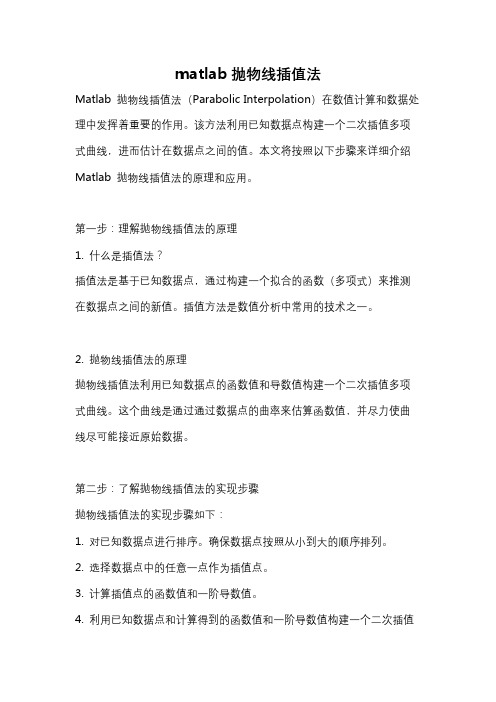
matlab抛物线插值法Matlab 抛物线插值法(Parabolic Interpolation)在数值计算和数据处理中发挥着重要的作用。
该方法利用已知数据点构建一个二次插值多项式曲线,进而估计在数据点之间的值。
本文将按照以下步骤来详细介绍Matlab 抛物线插值法的原理和应用。
第一步:理解抛物线插值法的原理1. 什么是插值法?插值法是基于已知数据点,通过构建一个拟合的函数(多项式)来推测在数据点之间的新值。
插值方法是数值分析中常用的技术之一。
2. 抛物线插值法的原理抛物线插值法利用已知数据点的函数值和导数值构建一个二次插值多项式曲线。
这个曲线是通过通过数据点的曲率来估算函数值,并尽力使曲线尽可能接近原始数据。
第二步:了解抛物线插值法的实现步骤抛物线插值法的实现步骤如下:1. 对已知数据点进行排序。
确保数据点按照从小到大的顺序排列。
2. 选择数据点中的任意一点作为插值点。
3. 计算插值点的函数值和一阶导数值。
4. 利用已知数据点和计算得到的函数值和一阶导数值构建一个二次插值多项式曲线。
5. 使用这个曲线进行插值计算。
第三步:编写Matlab 代码实现抛物线插值法下面是一个简单的使用Matlab 实现抛物线插值法的示例代码:生成一些已知数据点x = [1, 2, 3, 4, 5];y = [2, 4, 1, 6, 2];需要估计的插值点xi = 2.5;找到最接近插值点的两个已知数据点[~, index1] = min(abs(x - xi));index2 = index1 + 1;计算插值点的函数值和一阶导数值yi = y(index1) + (xi - x(index1)) * ((y(index2) - y(index1)) / (x(index2) - x(index1)));dyi = (y(index2) - y(index1)) / (x(index2) - x(index1));显示结果fprintf('插值点的函数值为: f\n', yi);fprintf('插值点的一阶导数值为: f\n', dyi);在这个示例中,我们使用了一组已知数据点(x 和y)。
插值MATLAB实现(牛顿差商插值误差龙格现象切比雪夫插值)
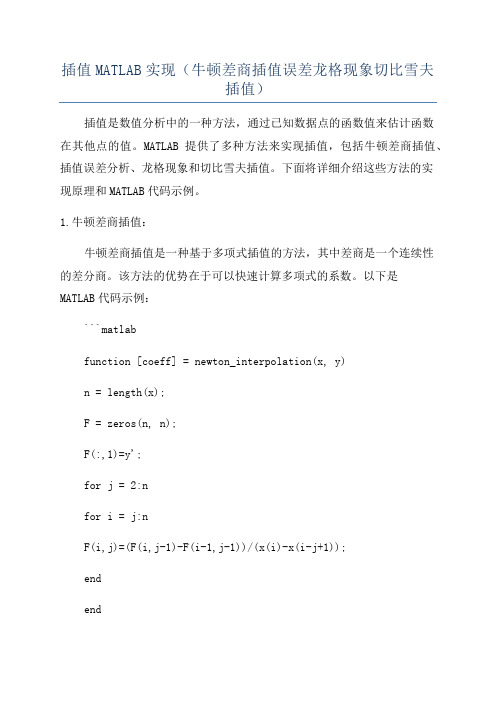
插值MATLAB实现(牛顿差商插值误差龙格现象切比雪夫插值)插值是数值分析中的一种方法,通过已知数据点的函数值来估计函数在其他点的值。
MATLAB提供了多种方法来实现插值,包括牛顿差商插值、插值误差分析、龙格现象和切比雪夫插值。
下面将详细介绍这些方法的实现原理和MATLAB代码示例。
1.牛顿差商插值:牛顿差商插值是一种基于多项式插值的方法,其中差商是一个连续性的差分商。
该方法的优势在于可以快速计算多项式的系数。
以下是MATLAB代码示例:```matlabfunction [coeff] = newton_interpolation(x, y)n = length(x);F = zeros(n, n);F(:,1)=y';for j = 2:nfor i = j:nF(i,j)=(F(i,j-1)-F(i-1,j-1))/(x(i)-x(i-j+1));endendcoeff = F(n, :);end```该代码中,输入参数x和y分别表示已知数据点的x坐标和y坐标,返回值coeff表示插值多项式的系数。
2.插值误差分析:插值误差是指插值函数与原始函数之间的差异。
一般来说,通过增加插值节点的数量或使用更高次的插值多项式可以减小插值误差。
以下是MATLAB代码示例:```matlabfunction [error] = interpolation_error(x, y, x_eval)n = length(x);p = polyfit(x, y, n-1);y_eval = polyval(p, x_eval);f_eval = sin(pi*x_eval);error = abs(f_eval - y_eval);end```该代码中,输入参数x和y分别表示已知数据点的x坐标和y坐标,x_eval表示插值节点的x坐标,error表示插值误差。
3.龙格现象:龙格现象是插值多项式在等距插值节点上错误增长的现象。
matlab三次样条插值例题解析

文章标题:深度解析Matlab三次样条插值1. 前言在数学和工程领域中,插值是一种常见的数值分析技术,它可以用来估计不连续数据点之间的值。
而三次样条插值作为一种常用的插值方法,在Matlab中有着广泛的应用。
本文将从简单到复杂,由浅入深地解析Matlab中的三次样条插值方法,以便读者更深入地理解这一技术。
2. 三次样条插值概述三次样条插值是一种利用分段三次多项式对数据点进行插值的方法。
在Matlab中,可以使用spline函数来进行三次样条插值。
该函数需要输入数据点的x和y坐标,然后可以根据需要进行插值操作。
3. 三次样条插值的基本原理在进行三次样条插值时,首先需要对数据点进行分段处理,然后在每个分段上构造出一个三次多项式函数。
这些多项式函数需要满足一定的插值条件,如在数据点处函数值相等、一阶导数相等等。
通过这些条件,可以得到一个关于数据点的插值函数。
4. Matlab中的三次样条插值实现在Matlab中,可以使用spline函数来进行三次样条插值。
通过传入数据点的x和y坐标,可以得到一个关于x的插值函数。
spline函数也支持在已知插值函数上进行插值点的求值,这为用户提供了极大的灵活性。
5. 三次样条插值的适用范围和局限性虽然三次样条插值在许多情况下都能够得到较好的插值效果,但也存在一些局限性。
在数据点分布不均匀或有较大噪音的情况下,三次样条插值可能会出现较大的误差。
在实际应用中,需要根据具体情况选择合适的插值方法。
6. 个人观点和总结通过对Matlab中三次样条插值的深度解析,我深刻地理解了这一插值方法的原理和实现方式。
在实际工程应用中,我会根据数据点的情况选择合适的插值方法,以确保得到准确且可靠的结果。
我也意识到插值方法的局限性,这为我在实际工作中的决策提供了重要的参考。
通过以上深度解析,相信读者已经对Matlab中的三次样条插值有了更加全面、深刻和灵活的理解。
在实际应用中,希望读者能够根据具体情况选择合适的插值方法,以提高工作效率和准确性。
牛顿插值matlab程序
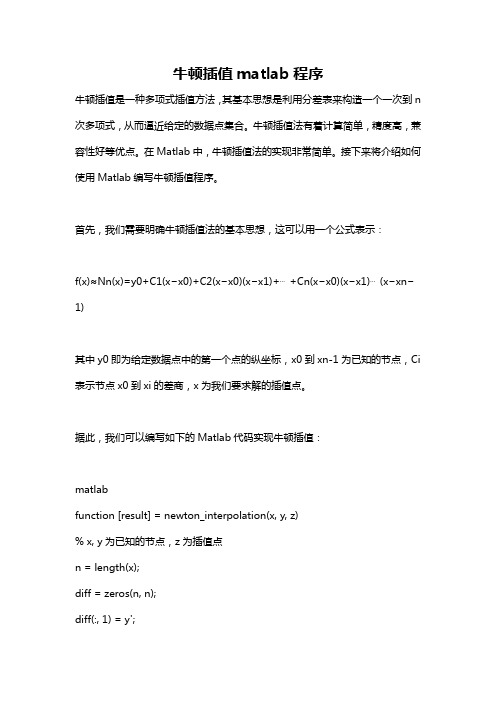
牛顿插值matlab程序牛顿插值是一种多项式插值方法,其基本思想是利用分差表来构造一个一次到n 次多项式,从而逼近给定的数据点集合。
牛顿插值法有着计算简单,精度高,兼容性好等优点。
在Matlab中,牛顿插值法的实现非常简单。
接下来将介绍如何使用Matlab编写牛顿插值程序。
首先,我们需要明确牛顿插值法的基本思想,这可以用一个公式表示:f(x)≈Nn(x)=y0+C1(x−x0)+C2(x−x0)(x−x1)+⋯+Cn(x−x0)(x−x1)⋯(x−xn−1)其中y0即为给定数据点中的第一个点的纵坐标,x0到xn-1为已知的节点,Ci 表示节点x0到xi的差商,x为我们要求解的插值点。
据此,我们可以编写如下的Matlab代码实现牛顿插值:matlabfunction [result] = newton_interpolation(x, y, z)% x, y为已知的节点,z为插值点n = length(x);diff = zeros(n, n);diff(:, 1) = y';for j = 2:nfor i = j:ndiff(i, j) = (diff(i, j-1) - diff(i-1, j-1)) / (x(i) - x(i-j+1));endendresult = diff(n, n);for k = n-1:-1:1result = diff(k, k) + (z - x(k)) * result;end我们首先定义一个函数newton_interpolation,其输入为已知节点x和纵坐标y,以及插值点z。
接着,我们使用双重循环来计算分差表,并按照公式计算插值多项式的值。
最后,我们得到了插值点z处的函数值。
需要注意的是,在计算分差表时,我们需要根据已知的节点计算出所有的差商,并记录在diff中。
在计算插值点z处的函数值时,我们需要按照公式从n-1到0依次计算出多项式的各项系数。
matlab中的克里金插值

MATLAB中的克里金插值1. 引言克里金插值是一种常用的空间插值方法,用于根据已知数据点的空间分布,推断未知点的值。
在MATLAB中,克里金插值是通过kriging函数实现的。
本文将介绍克里金插值的原理、MATLAB中的使用方法以及一些实际应用案例。
2. 克里金插值原理克里金插值基于克里金变异函数,该函数描述了空间上的变量之间的相关性。
克里金插值的基本思想是通过已知数据点的空间分布和变异函数的参数,来推断未知点的值。
克里金变异函数通常使用高斯模型、指数模型或球状模型等。
这些模型都具有一个参数,称为克里金范围,用于描述变量之间的空间相关性。
通过调整克里金范围,可以控制插值结果的平滑程度。
3. MATLAB中的克里金插值在MATLAB中,克里金插值可以使用kriging函数实现。
该函数的基本语法如下:[Z, varZ] = kriging(X, Y, Z, Xq, model)参数说明: - X:已知数据点的x坐标 - Y:已知数据点的y坐标 - Z:已知数据点的值 - Xq:待插值点的x坐标 - model:克里金变异函数的模型函数返回值: - Z:插值结果的值 - varZ:插值结果的方差使用kriging函数进行克里金插值的步骤如下: 1. 准备已知数据点的坐标和值。
2. 定义待插值点的坐标。
3. 选择合适的克里金变异函数模型。
4. 调用kriging函数进行插值,获取插值结果和方差。
4. 克里金插值的实际应用克里金插值在地质学、环境科学、农业等领域有广泛的应用。
下面以一个简单的二维插值问题为例,演示克里金插值在MATLAB中的应用。
假设有一片土地,已知某些地点的土壤含水量,我们希望通过这些已知点的数据,推断整个土地上未知点的土壤含水量。
首先,我们准备已知数据点的坐标和值。
假设有5个已知点,其坐标和土壤含水量如下:X坐标Y坐标土壤含水量X坐标Y坐标土壤含水量1 1 0.22 2 0.33 3 0.44 4 0.55 5 0.6接下来,我们定义待插值点的坐标。
matlab插值表达式
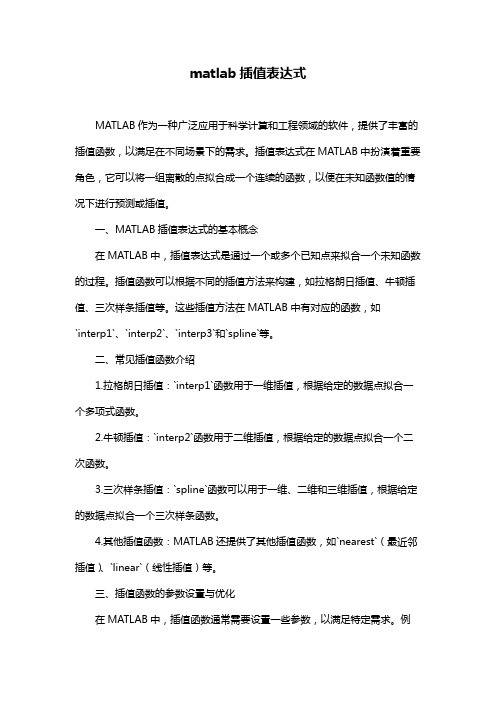
matlab插值表达式MATLAB作为一种广泛应用于科学计算和工程领域的软件,提供了丰富的插值函数,以满足在不同场景下的需求。
插值表达式在MATLAB中扮演着重要角色,它可以将一组离散的点拟合成一个连续的函数,以便在未知函数值的情况下进行预测或插值。
一、MATLAB插值表达式的基本概念在MATLAB中,插值表达式是通过一个或多个已知点来拟合一个未知函数的过程。
插值函数可以根据不同的插值方法来构建,如拉格朗日插值、牛顿插值、三次样条插值等。
这些插值方法在MATLAB中有对应的函数,如`interp1`、`interp2`、`interp3`和`spline`等。
二、常见插值函数介绍1.拉格朗日插值:`interp1`函数用于一维插值,根据给定的数据点拟合一个多项式函数。
2.牛顿插值:`interp2`函数用于二维插值,根据给定的数据点拟合一个二次函数。
3.三次样条插值:`spline`函数可以用于一维、二维和三维插值,根据给定的数据点拟合一个三次样条函数。
4.其他插值函数:MATLAB还提供了其他插值函数,如`nearest`(最近邻插值)、`linear`(线性插值)等。
三、插值函数的参数设置与优化在MATLAB中,插值函数通常需要设置一些参数,以满足特定需求。
例如,在`interp1`函数中,可以设置插值基函数的阶数(`polyorder`参数);在`spline`函数中,可以设置插值节点的数量(` knot`参数)等。
合理的参数设置可以提高插值函数的精度和实用性。
四、插值表达式在MATLAB中的应用实例1.数据拟合:利用插值表达式将实验数据拟合成连续的函数,以便进行后续的分析和预测。
2.图像插值:在图像处理中,插值表达式可以用于提高图像的分辨率,或修复图像中的缺失区域。
3.数值计算:在数值计算领域,插值表达式可以用于求解微分方程、积分等问题。
五、插值表达式的优缺点分析1.优点:插值表达式可以有效地将离散的数据点拟合成连续的函数,便于进行后续的计算和分析。
牛顿插值法matlab程序例题

牛顿插值法是一种常用的数值分析方法,用于构造一个多项式函数,以便在给定的数据点上进行插值。
这个主题在数学和工程领域中有着广泛的应用,特别是在数据拟合和函数逼近方面。
牛顿插值法的核心思想是通过不断地添加新的数据点来构造一个多项式,并利用已知数据点来确定多项式的系数,从而实现对未知数据点的插值预测。
在Matlab中,实现牛顿插值法并不困难,我们可以利用已有的函数和工具来简化计算过程。
下面,我们将通过一个具体的例题来讲解如何使用Matlab编写牛顿插值法的程序,并分析其结果。
我们需要明确牛顿插值法的数学原理。
给定n个互不相同的节点\(x_0, x_1, ... , x_n\),以及在这些节点上的函数值\(f(x_0), f(x_1), ... , f(x_n)\),我们希望构造一个n次插值多项式p(x),满足p(x_i) = f(x_i),i=0,1,...,n。
牛顿插值多项式的一般形式为:\[p(x) = a_0 + a_1(x - x_0) + a_2(x - x_0)(x - x_1) + ... + a_n(x -x_0)(x - x_1)...(x - x_{n-1})\]其中,\[a_i\]表示插值多项式的系数。
通过牛顿插值法的迭代过程,可以逐步求解出这些系数,进而得到插值多项式的表达式。
接下来,我们将以一个具体的例题来演示如何在Matlab中实现牛顿插值法。
假设我们有如下的数据点和函数值:\(x = [1, 2, 3, 4]\)\(f(x) = [1, 4, 9, 16]\)我们希望利用这些数据点来构造一个插值多项式,并在给定的区间上进行插值计算。
在Matlab中,可以通过interp1函数来进行插值计算,该函数支持多种插值方法,包括牛顿插值法。
下面是一个简单的Matlab程序示例:```matlabx = [1, 2, 3, 4];y = [1, 4, 9, 16];xi = 2.5;yi = interp1(x, y, xi, 'spline');disp(['在x=',num2str(xi),'处的插值结果为:',num2str(yi)]);```在这段代码中,我们首先定义了给定的数据点x和对应的函数值y,然后利用interp1函数对x=2.5处的插值结果进行计算。
matlab插值(详细 全面)范文
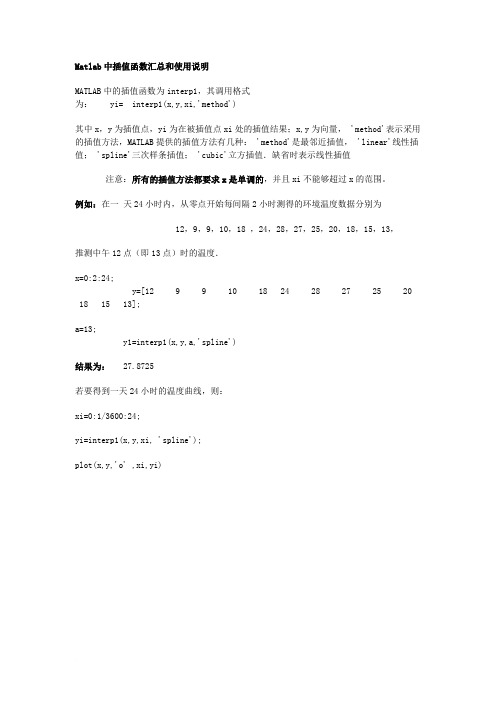
Matlab中插值函数汇总和使用说明MATLAB中的插值函数为interp1,其调用格式为:yi= interp1(x,y,xi,'method')其中x,y为插值点,yi为在被插值点xi处的插值结果;x,y为向量, 'method'表示采用的插值方法,MATLAB提供的插值方法有几种: 'method'是最邻近插值, 'linear'线性插值; 'spline'三次样条插值; 'cubic'立方插值.缺省时表示线性插值注意:所有的插值方法都要求x是单调的,并且xi不能够超过x的范围。
例如:在一天24小时内,从零点开始每间隔2小时测得的环境温度数据分别为12,9,9,10,18 ,24,28,27,25,20,18,15,13,推测中午12点(即13点)时的温度.x=0:2:24;y=[12 9 9 10 18 24 28 27 25 20 18 15 13];a=13;y1=interp1(x,y,a,'spline')结果为: 27.8725若要得到一天24小时的温度曲线,则:xi=0:1/3600:24;yi=interp1(x,y,xi, 'spline');plot(x,y,'o' ,xi,yi)命令1 interp1功能一维数据插值(表格查找)。
该命令对数据点之间计算内插值。
它找出一元函数f(x)在中间点的数值。
其中函数f(x)由所给数据决定。
x:原始数据点Y:原始数据点xi:插值点Yi:插值点格式(1)yi = interp1(x,Y,xi)返回插值向量yi,每一元素对应于参量xi,同时由向量x 与Y 的内插值决定。
参量x 指定数据Y 的点。
若Y 为一矩阵,则按Y 的每列计算。
yi 是阶数为length(xi)*size(Y,2)的输出矩阵。
MATLAB应用多项式插值

多项式为 y 0.2015x3 1.4385x2 2.7477x 5.4370 Polyfit的第三个参数是多项式的阶数。
要求导数值也相等,甚至要求高阶导数值也相等,满足 这一要求的插值多项式就是Hermite插值多项式。下面 只讨论函数值与一阶导数值个数相等且已知的情况。
已知n个插值点 x1, x2, , xn 及对应的函数值 y1, y2, , yn 和一阶导数值 y1', y2', , y'n 。则对插值区间 内任意x的函数值y的Hermite插值公式:
n
y(x) hi[(xi x)(2ai yi yi' ) yi ] i 1
其中
hi
n ( x xj )2; j1 xi x j
ji
ai
n j 1
xi
1 xj
ji
• MATLAB实现
% hermite.m
function y=hermite(x0,y0,y1,x)
n
y(x) hi[(xi x)(2ai yi yi' ) yi ]
• polyval: 可用命令polyval计算多项式的值。 例: y 3x4 7x3 2x2 x 1 计算y(2.5)
>> c=[3,-7,2,1,1]; xi=2.5; yi=polyval(c,xi) yi =
23.8125 如果xi是含有多个横坐标值的数组,则yi也
为与xi长度相同的向量。 >> c=[3,-7,2,1,1]; xi=[2.5,3]; >> yi=polyval(c,xi) yi =
拉格朗日插值matlab程序例题

拉格朗日插值是一种常用的数据拟合方法,它可以通过已知数据点来估计出未知数据点的值。
在数学和工程领域中,拉格朗日插值经常被用来进行数据的近似和预测。
在本文中,我们将深入探讨拉格朗日插值的原理和应用,并以Matlab程序例题来展示其实际运用。
1. 拉格朗日插值的原理拉格朗日插值是利用已知数据点来构造一个多项式,通过这个多项式来拟合数据并进行预测。
它的原理基于拉格朗日多项式的概念,即通过已知的n个点来构造一个n-1次的拉格朗日多项式,利用这个多项式来估计其他点的数值。
2. 拉格朗日插值的公式假设有n个已知的数据点(x1, y1), (x2, y2), …, (xn, yn),则拉格朗日插值多项式可以表示为:L(x) = Σ(yi * li(x)), i=1 to n其中li(x)是拉格朗日基函数,定义为:li(x) = Π((x - xj) / (xi - xj)), j=1 to n, j≠i利用这个公式,我们可以得到拉格朗日插值多项式,进而进行数据的拟合和预测。
3. 拉格朗日插值的Matlab程序实现下面我们将以一个具体的例题来展示如何使用Matlab来实现拉格朗日插值。
假设有如下数据点:y = [10, 5, 8, 3, 6];我们希望利用这些数据点来构造拉格朗日插值多项式,并使用这个多项式来估计x=3.5处的数值。
我们可以编写Matlab程序来实现拉格朗日插值。
代码如下:```matlabfunction result = lagrange_interpolation(x, y, xx)n = length(x);result = 0;for i = 1:ntemp = y(i);for j = 1:nif i ~= jtemp = temp * (xx - x(j)) / (x(i) - x(j));endendresult = result + temp;endend```我们可以调用这个函数来进行插值计算:```matlaby = [10, 5, 8, 3, 6];xx = 3.5;result = lagrange_interpolation(x, y, xx)disp(result);```通过这段程序,我们可以得到x=3.5处的插值结果为6.75。
matlab编写拉格朗日插值法案例
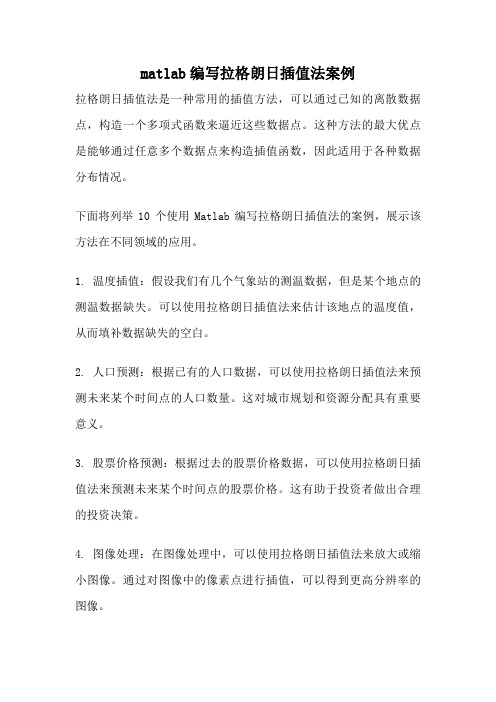
matlab编写拉格朗日插值法案例拉格朗日插值法是一种常用的插值方法,可以通过已知的离散数据点,构造一个多项式函数来逼近这些数据点。
这种方法的最大优点是能够通过任意多个数据点来构造插值函数,因此适用于各种数据分布情况。
下面将列举10个使用Matlab编写拉格朗日插值法的案例,展示该方法在不同领域的应用。
1. 温度插值:假设我们有几个气象站的测温数据,但是某个地点的测温数据缺失。
可以使用拉格朗日插值法来估计该地点的温度值,从而填补数据缺失的空白。
2. 人口预测:根据已有的人口数据,可以使用拉格朗日插值法来预测未来某个时间点的人口数量。
这对城市规划和资源分配具有重要意义。
3. 股票价格预测:根据过去的股票价格数据,可以使用拉格朗日插值法来预测未来某个时间点的股票价格。
这有助于投资者做出合理的投资决策。
4. 图像处理:在图像处理中,可以使用拉格朗日插值法来放大或缩小图像。
通过对图像中的像素点进行插值,可以得到更高分辨率的图像。
5. 数字信号处理:在数字信号处理中,可以使用拉格朗日插值法来重构缺失的信号样本。
这有助于恢复被噪声污染或丢失的信号。
6. 机器学习:在机器学习中,拉格朗日插值法可以用于处理缺失数据。
通过对已有数据进行插值,可以构造更完整的数据集,提高模型的准确性。
7. 地理信息系统:在地理信息系统中,可以使用拉格朗日插值法来生成等高线图。
通过对不同高度的离散数据点进行插值,可以得到连续的等高线分布。
8. 数值积分:在数值积分中,可以使用拉格朗日插值法来近似计算定积分。
通过将被积函数进行插值,可以将积分转化为对插值多项式的求和。
9. 电力系统分析:在电力系统分析中,可以使用拉格朗日插值法来估计电力负荷曲线。
通过对已知的电力负荷数据进行插值,可以预测未来的负荷变化趋势。
10. 信号滤波:在信号滤波中,可以使用拉格朗日插值法来对信号进行平滑处理。
通过对信号进行插值,可以去除噪声和异常值,得到更干净的信号。
hermite插值计算公式matlab例题
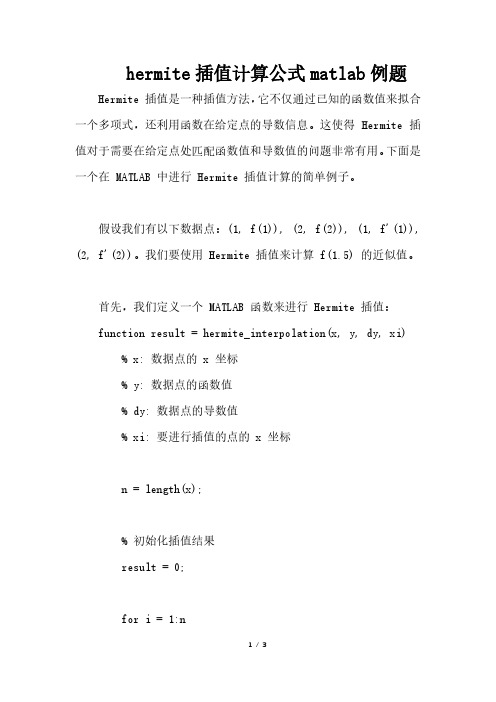
hermite插值计算公式matlab例题Hermite 插值是一种插值方法,它不仅通过已知的函数值来拟合一个多项式,还利用函数在给定点的导数信息。
这使得 Hermite 插值对于需要在给定点处匹配函数值和导数值的问题非常有用。
下面是一个在 MATLAB 中进行 Hermite 插值计算的简单例子。
假设我们有以下数据点:(1, f(1)), (2, f(2)), (1, f'(1)), (2, f'(2))。
我们要使用 Hermite 插值来计算 f(1.5) 的近似值。
首先,我们定义一个 MATLAB 函数来进行 Hermite 插值:function result = hermite_interpolation(x, y, dy, xi)% x: 数据点的 x 坐标% y: 数据点的函数值% dy: 数据点的导数值% xi: 要进行插值的点的 x 坐标n = length(x);% 初始化插值结果result = 0;for i = 1:n% 计算 Lagrange 基函数的权重Li = 1;for j = 1:nif j ~= iLi = Li * (xi - x(j)) / (x(i) - x(j));endend% Hermite 插值基函数的权重Hi = (1 - 2 * (xi - x(i)) * polyval(polyder(poly(x)), x(i))) * Li^2;% 插值结果的累加result = result + y(i) * Hi + dy(i) * Li;endend接下来,我们使用这个函数进行 Hermite 插值:% 给定数据点x = [1, 2];y = [f(1), f(2)];dy = [f_prime(1), f_prime(2)];% 要进行插值的点xi = 1.5;% 进行 Hermite 插值result = hermite_interpolation(x, y, dy, xi);% 显示插值结果disp(['Hermite interpolation at x = ', num2str(xi), ' is ', num2str(result)]);在这里,f 和 f_prime 是你实际的函数和导数函数。
(完整word版)matlab插值法实例
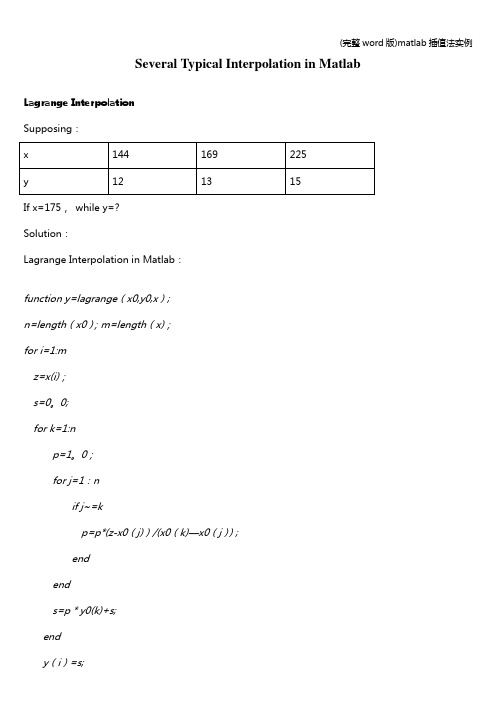
Lagrange Interpolation
Supposing:
x
144
169
225
y
12
13
15Ifxຫໍສະໝຸດ 175,whiley=?Solution:
Lagrange Interpolation in Matlab:
function y=lagrange(x0,y0,x);
y4 = interp1(x, y, xi, ’cubic’);
plot(x, y , 'o', xi ,y1 ,'g-' ,xi ,y2 ,’r:' ,xi ,y3 ,’k—.', xi, y4, ’b-—');
legend('Original’, 'Nearest’, 'Linear', 'Spline', ’Cubic’);
for i=1:n;
z=ones(1,m);
for k=1:i-1;
z=z.*(xi-x(k));
end
yi=yi+Y(1,i)*z;
end
input:
x=[1 4 9];
y=[1 2 3];
xi=[5 6];
yi=newint(x,y,xi);
operate the program and obtain the answer:
Solution:
Inputx=[ 1 4 9 6];y=[ 1 4 9 6];x=[ 1 4 9 6];pp=spline(x,y)
pp =
form: 'pp’
breaks: [1 4 6 9]
matlab拟合函数并插值

matlab拟合函数并插值在MATLAB中进行拟合函数并插值可以通过以下步骤实现:1. 准备数据:首先,您需要准备要进行拟合和插值的数据。
这可以是一组x和y值,其中x是输入数据,y是对应的目标输出数据。
2. 拟合函数:使用MATLAB中的拟合函数来对数据进行拟合。
例如,您可以使用`fit`函数来拟合一组数据。
以下是一个简单的例子:```matlabx = [1, 2, 3, 4, 5]; % 输入数据y = [2, 3, 5, 7, 11]; % 输出数据fitresult = fit(x', y', 'poly1'); % 拟合一个一次多项式函数```在这个例子中,我们使用了`fit`函数来拟合一组输入数据`x`和输出数据`y`,并指定了要拟合的函数类型为一次多项式。
`fit`函数将返回拟合的结果,其中包含了拟合的函数表达式和拟合参数等信息。
3. 进行插值:一旦您完成了拟合,您可以使用插值方法来预测新的输入数据对应的输出值。
在MATLAB中,插值可以通过使用`interp1`函数来实现。
以下是一个简单的例子:```matlabxnew = [1.5, 2.5, 3.5, 4.5]; % 新的输入数据ynew = interp1(fitresult, xnew); % 使用拟合结果进行插值```在这个例子中,我们使用了`interp1`函数来对新的输入数据进行插值,并使用了之前拟合的结果作为插值函数的参数。
`interp1`函数将返回对应于新的输入数据`xnew`的插值结果`ynew`。
在MATLAB中进行拟合函数并插值需要准备数据、使用拟合函数进行拟合、使用插值函数进行插值。
这些步骤可以帮助您在MATLAB中实现拟合和插值的功能。
matlab newton插值法

matlab newton插值法
在MATLAB 中实现Newton 插值法,您可以使用内置的polyfit和polyval函数。
下面是一个简单的例子,它展示了如何使用Newton 插值法在MATLAB 中拟合数据。
首先,我们需要一些数据来进行插值。
假设我们有一些x 和y 的数据点:
matlab
x = [1, 2, 3, 4, 5];
y = [1, 4, 9, 16, 25];
这些数据点表示一个函数y = x^2 的取值。
然后,我们可以使用polyfit函数来找到最佳拟合的多项式。
polyfit函数返回一个数组,该数组表示多项式的系数,从最高次幂到最低次幂。
例如,对于二次多项式,它会返回一个包含三个系数的数组:a2, a1 和a0。
matlab
p = polyfit(x, y, 2); % 对于二次多项式,我们使用2作为第三个参数
现在,p包含多项式的系数。
我们可以使用polyval函数来评估多项式在给定x 值
处的y 值:
matlab
y_fit = polyval(p, x);
最后,我们可以绘制原始数据和拟合曲线:
matlab
plot(x, y, 'o', x, y_fit, '-');
legend('Data', 'Fitted curve');
以上就是如何在MATLAB 中使用Newton 插值法进行数据拟合的简单示例。
注意,对于非线性函数,您可能需要使用更高阶的多项式来获得更好的拟合效果。
拉格朗日插值函数matlab例题
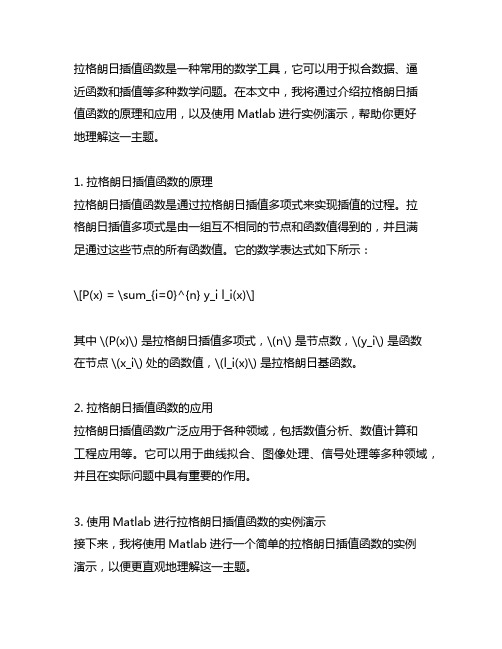
拉格朗日插值函数是一种常用的数学工具,它可以用于拟合数据、逼近函数和插值等多种数学问题。
在本文中,我将通过介绍拉格朗日插值函数的原理和应用,以及使用Matlab进行实例演示,帮助你更好地理解这一主题。
1. 拉格朗日插值函数的原理拉格朗日插值函数是通过拉格朗日插值多项式来实现插值的过程。
拉格朗日插值多项式是由一组互不相同的节点和函数值得到的,并且满足通过这些节点的所有函数值。
它的数学表达式如下所示:\[P(x) = \sum_{i=0}^{n} y_i l_i(x)\]其中 \(P(x)\) 是拉格朗日插值多项式,\(n\) 是节点数,\(y_i\) 是函数在节点 \(x_i\) 处的函数值,\(l_i(x)\) 是拉格朗日基函数。
2. 拉格朗日插值函数的应用拉格朗日插值函数广泛应用于各种领域,包括数值分析、数值计算和工程应用等。
它可以用于曲线拟合、图像处理、信号处理等多种领域,并且在实际问题中具有重要的作用。
3. 使用Matlab进行拉格朗日插值函数的实例演示接下来,我将使用Matlab进行一个简单的拉格朗日插值函数的实例演示,以便更直观地理解这一主题。
```matlab% 拉格朗日插值函数的实例演示x = [1, 2, 3, 4]; % 设定节点y = [1, 4, 9, 16]; % 对应的函数值xx = 1:0.1:4; % 生成插值点yy = zeros(size(xx)); % 初始化插值结果for i = 1:length(x)L = ones(size(xx));for j = 1:length(x)if j ~= iL = L.*(xx-x(j))/(x(i)-x(j));endendyy = yy + y(i)*L; % 计算插值结果endplot(x,y,'o',xx,yy,'-'); % 绘制插值结果xlabel('x'); ylabel('y');legend('节点','插值结果');```在这个实例中,我们首先定义了一组节点\(x\) 和对应的函数值\(y\),然后生成了插值点 \(xx\),利用拉格朗日插值多项式计算了插值结果\(yy\),最后使用Matlab进行了绘图展示。
matlab中的克里金插值

matlab中的克里金插值(原创实用版)目录1.Matlab 中的克里金插值简介2.克里金插值的原理3.Matlab 中克里金插值的实现方法4.克里金插值在 Matlab 中的应用实例5.总结正文一、Matlab 中的克里金插值简介克里金插值(Kriging Interpolation)是一种插值方法,主要应用于空间数据的预测和估计。
克里金插值方法基于最小二乘法,可以有效地处理数据中的不确定性和空间相关性。
Matlab 作为一种广泛应用于科学计算和数据分析的软件,提供了克里金插值的相关函数和工具箱,为用户提供了方便的克里金插值实现途径。
二、克里金插值的原理克里金插值的原理是基于随机过程理论和最小二乘法。
首先,将空间数据视为一个随机场,通过构建随机过程的协方差矩阵来描述数据中的空间相关性。
然后,利用最小二乘法原理,求解协方差矩阵的克里金权重,得到空间变量的预测值。
克里金插值的基本步骤包括:1.构建随机场2.计算协方差矩阵3.计算克里金权重4.进行插值预测三、Matlab 中克里金插值的实现方法在 Matlab 中,可以使用“spatial”工具箱中的函数实现克里金插值。
以下是一个简单的克里金插值示例:1.导入数据2.构建随机场3.计算协方差矩阵4.计算克里金权重5.进行插值预测四、克里金插值在 Matlab 中的应用实例克里金插值在 Matlab 中可以应用于各种空间数据的预测和估计,例如地形高度、空气污染浓度等。
这里以一个简单的地形高度数据为例,展示克里金插值的应用过程。
1.读取地形数据2.创建一个网格坐标3.使用克里金插值函数进行插值4.显示插值结果五、总结克里金插值是一种有效的空间数据预测方法,Matlab 提供了丰富的克里金插值相关函数和工具箱,方便用户进行克里金插值计算。
